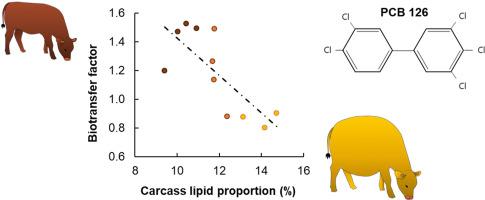Chemosphere ( IF 8.1 ) Pub Date : 2021-01-23 , DOI: 10.1016/j.chemosphere.2021.129698 Charlotte Driesen , Markus Zennegg , Isabelle Morel , Hans Dieter Hess , Bernd Nowack , Sylvain Lerch

|
Food of animal origin accounts for >90% of the overall human exposure to polychlorinated biphenyls (PCBs). Food regulatory maximum levels help to control this exposure, but bovine meat has been found to be prone to exceed those occasionally. In order to ensure the chemical safety of bovine meat, the aim was to explore the dependency of the bioconcentration (BCF) and biotransfer (BTF) factor, and assimilation efficiency (AE) of PCBs on carcass lipid proportion and growth rate of beef cattle. Eleven bulls were fattened for 293 days with three different diets (7.0, 7.4, 7.5 MJ net energy for growth kg-1 dry matter) at PCB background levels, until slaughter at 530 or 600 kg body weight. Feed and perirenal adipose tissue were sampled for PCB analyses via GC/HRMS and carcass lipid proportion was estimated by the 11th rib dissection technique. For all tested PCBs, BCF (ranging from 0.7 to 18.4) and BTF (ranging from 0.1 to 2.7) decreased at least 1.5 up to 10.6-fold when the carcass lipid proportion increased by 4%, resulting from a typical dilution process. For a faster growth rate of 0.18 kg d-1 however, only a non-significant increasing trend in transfer factors (1.1 to 2.1-fold) was seen. Besides, the transfer factors increased with PCB chlorination degree, non-ortho substitution and lipophilicity. These results underpin the complex interaction between animal physiology and PCB physicochemical properties, making it challenging to interpret average transfer factors to support chemical risk assessment and management.
中文翻译:

平均转移因子还不够:牛的生理生长对饲料中多氯联苯从脂肪到脂肪的转移速率的影响
动物源性食品占人类接触多氯联苯(PCBs)总量的90%以上。食品监管最高水平有助于控制这种暴露,但已发现牛肉往往超过偶尔的水平。为了确保牛肉的化学安全性,目的是探索多氯联苯的生物浓度(BCF)和生物转移(BTF)因子以及同化效率(AE)对肉牛lipid体脂质比例和生长率的依赖性。在PCB背景水平下,用三种不同的饮食(7.0、7.4、7.5 MJ净生长公斤-1干物质的净能量)将11头公牛增肥293天,直到以530或600公斤体重宰杀。通过GC / HRMS对饲料和肾周脂肪组织进行PCB分析,并由11个肋解剖技术。对于所有测试的多氯联苯,当the体脂质比例增加4%时,BCF(0.7至18.4)和BTF(0.1至2.7)至少下降1.5至10.6倍,这是典型的稀释过程所致。但是,对于更快的0.18 kg d -1的生长速度,仅观察到转移因子的显着增加趋势(1.1到2.1倍)。此外,转移因子随着PCB氯化度,非邻位取代和亲脂性的增加而增加。这些结果支撑了动物生理学与PCB物理化学特性之间复杂的相互作用,使其难以解释平均转移因子以支持化学风险评估和管理。











































 京公网安备 11010802027423号
京公网安备 11010802027423号